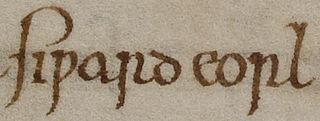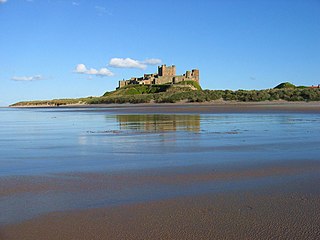Waltheof, Earl of Northumbria was the last of the Anglo-Saxon earls and the only English aristocrat to be executed during the reign of William I.

Siward or Sigurd was an important earl of 11th-century northern England. The Old Norse nickname Digri and its Latin translation Grossus are given to him by near-contemporary texts. It is possible Siward may have been of Scandinavian or Anglo-Scandinavian origin, perhaps a relative of Earl Ulf, although this is speculative and unclear. He emerged as a powerful regional strongman in England during the reign of Cnut. Cnut was a Scandinavian ruler who conquered England in the 1010s, and Siward was one of the many Scandinavians who came to England in the aftermath of that conquest. Siward subsequently rose to become sub-ruler of most of northern England. From 1033 at the latest Siward was in control of southern Northumbria, that is, present-day Yorkshire, governing as earl on Cnut's behalf.
In Anglo-Saxon England, the Earl of York or Ealdorman of York was the ruler of the southern half of Northumbria. The titles ealdorman and earl both come from Old English. The ealdormanry (earldom) seems to have been created in 966 following a period when the region was under the control of Oswulf, already high-reeve of Bamburgh in northern Northumbria, from about 954, when Norse rule at York came to an end.
Aldhun of Durham, also known as Ealdhun, was the last Bishop of Lindisfarne and the first Bishop of Durham. He was of "noble descent".
Earl of Northumbria was a title in the late Anglo-Saxon, Anglo-Scandinavian and early Anglo-Norman period in England. The earldom of Northumbria was the successor of the earldom of Bamburgh. In the seventh century, the Anglo-Saxon kingdoms of Bernicia and Deira were united in the kingdom of Northumbria, but this was destroyed by the Vikings in 867. Southern Northumbria, the former Deira, then became the Viking kingdom of York, while English earls ruled the former northern kingdom of Bernicia from their base at Bamburgh. The northern part of Bernicia was lost to the Scots, probably in the late tenth century. In 1006 Uhtred the Bold was earl of Bamburgh, and Æthelred the Unready appointed him earl of York as well, re-uniting the area of Northumbria still under English control into a single earldom. Uhtred was murdered in 1016, and Cnut then appointed Eric of Hlathir earl of Northumbria at York, but Uhtred's dynasty held onto Bernicia until 1041, when the earldom was again united. A descendant of Uhtred, Gospatric, was appointed earl by William the Conqueror in 1067, but William expelled him in 1072. Gospatric was then given lands in Scotland, and his descendants became earls of Dunbar. Northumbria was divided again along the Tees in the early Norman period and dissolved into the earldoms of York and Northumberland, with the latter including numerous autonomous liberties such as the County Palatine of Durham and Liberty of Tynedale.
Osulf or Oswulf was the son of Eadwulf IV, Earl of Bamburgh, and grandson of Uhtred the Bold, ruler of Bamburgh and ealdorman of Northumbria. Oswulf’s family ruled Bamburgh from 954 until 1041, though their independence may have been compromised after 1041 when Siward the Stout killed Eadwulf and gained hegemony over the north.
Eadwulf or Eadulf was a ruler in Northumbria in the early tenth century. A genealogy in the text De Northumbria post Britannos recording the ancestry of Waltheof Earl of Northampton, suggests that Osulf was the son of Eadwulf, the ′King of the Northern English′. This goes on to say that Eadwulf was the son of Æthelthryth daughter of Ælla, King of Northumbria.
Ealdred was a ruler of Bamburgh, at least part of the former kingdom of Bernicia in northern Northumbria, in the early tenth century. He was the son of Eadwulf.
Uhtred or Uchtred, called the Bold, was the ealdorman of Northumbria from 1006 to 1016, when he was assassinated. He was the son of Waltheof I, ealdorman of Bamburgh (Bebbanburg), whose ancient family had ruled from the castle of Bamburgh on the Northumbrian coast and was involved in the generations-long blood feud described in De obsessione Dunelmi.

Oswulf was ruler of Bamburgh and subsequently, according to later tradition, commander of all Northumbria under the lordship of King Eadred of England. He is sometimes called "earl" or "high reeve", though the precise title of the rulers of Bamburgh is unclear. By the twelfth century Oswulf was held responsible for the death of Northumbria's last Norse king, Eric of York, subsequently administering the Kingdom of York on behalf of Eadred.
Waltheof was high-reeve or ealdorman of Bamburgh. He was probably the son of Ealdred, and the grandson of Osulf I and was father of Uhtred the Bold, Ealdorman of Northumbria. His name is Scandinavian which may imply that he had Viking ancestors.
Eadwulf III of Bamburgh or Eadwulf Cudel or Cutel was ruler of Bamburgh for some period in the early eleventh century. Following the successful takeover of York by the Vikings in 866/7, southern Northumbria became part of the Danelaw, but in the north English rulers held on from a base at Bamburgh. They were variously described as kings, earls, princes or high-reeves, and their independence from the kings of England and Scotland is uncertain. Uhtred the Bold and Eadwulf Cudel were sons of Waltheof, ruler of Bamburgh, who died in 1006. He was succeeded by Uhtred, who was appointed by Æthelred the Unready as earl in York, with responsibility for the whole of Northumbria. Uhtred was murdered in 1016, and king Cnut then appointed Erik, son of Hakon, earl at York, while Eadwulf succeeded at Bamburgh.
Ealdred was an Earl in north-east England from the death of his uncle, Eadwulf Cudel, soon after 1018 until his murder in 1038. He is variously described by historians as Earl of Northumbria, Earl of Bernicia and Earl of Bamburgh, his stronghold on the Northumbrian coast. He was the son of Uhtred, Earl of Northumbria, who was murdered by Thurbrand the Hold in 1016 with the connivance of Cnut. Ealdred's mother was Ecgfrida, daughter of Aldhun, bishop of Durham.
Events from the 1040s in England.
De obsessione Dunelmi, is an historical work written in the north of England during the Anglo-Norman period, almost certainly at Durham, and probably in either the late 11th- or early 12th-century.
Eadulf Rus was an 11th-century Northumbrian noble, and the first recorded 'of Swinton'. He was either the son or grandson of Gospatric, possibly the man who soon after Christmas 1064 was allegedly killed on behalf of Tostig, Earl of Northumbria. This murder by Tostig led to a great northern revolt against Edward the Confessor, a revolt that turned both King Edward and Harold Godwinson against Tostig and led to the appointment of the Mercian, Morcar, as Earl of northern England.

Oslac ealdorman of York from around 963 to 975. His territory included but may not have been limited to the southern half of Northumbria. His background is obscure because of poor source documentation. The latter has facilitated disagreement amongst historians regarding his family and ethnicity.

The Rulers of Bamburgh were significant regional potentates in what is now northern England and south-eastern Scotland during the Viking Age. Sometimes referred to in modern sources as the Earldom of Bamburgh, their polity existed for roughly two centuries, beginning after the attacks on the Anglo-Saxon Kingdom of Northumbria by the Vikings in the later ninth century, and ending after the Norman Conquest later in the eleventh century. In Scottish and Irish sources of the period the Bamburgh 'earldom' is referred to as the kingship of the Northern English. or simply of the 'Saxons'.
Thurbrand, nicknamed "the Hold", was a Northumbrian magnate in the early 11th-century. Perhaps based in Holderness and East Yorkshire, Thurbrand was recorded as the killer of Uhtred the Bold, Earl of Northumbria. The killing appears to have been part of the war between Sweyn Forkbeard and Cnut the Great against the English king Æthelred the Unready, Uhtred being the latter's chief Northumbrian supporter. Thurbrand may also have attested a charter of 1009 and given a horse to Æthelred's son Æthelstan Ætheling. The killing is the first known act, if it did not initiate, a bloodfeud between Thurbrand's family and Uhtred going into the time of Earl Waltheof. It is possible that Holderness took its name because of Thurbrand's presence or ownership of the peninsula.
Eadwulf II, nicknamed Evil-child, was ruler of Bamburgh in the late tenth century. Although Eadwulf is sometimes described as the Earl of Northumbria, he ruled only a northern portion of Northumbria, a polity centred on Bamburgh that once stretched from the Firth of Forth to the River Tees.



